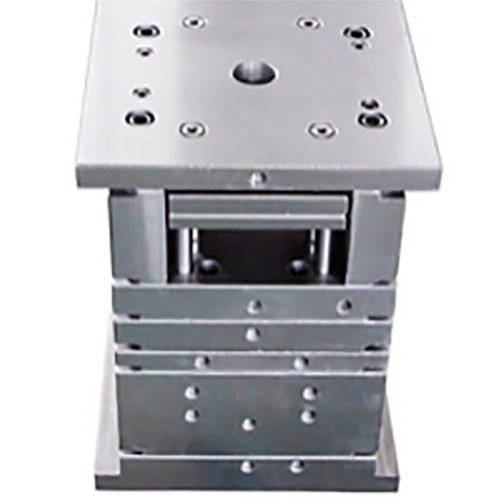Introduction and use of injection mold base
2025-03-28
Core functions and structural components of mold frame
1. Basic definition
The mold frame of an injection mold is the skeleton system of the mold, providing precise positioning and structural support for molded parts. The quality of the mold frame directly affects the mold life (up to 500,000 to 1 million times of opening and closing) and product dimensional accuracy (up to ±0.02mm)
2. Typical structure
1). Basic module: base, fixed block. Made of QT600 ductile iron, flatness ≤0.02mm/m, can withstand clamping force up to 3000T
2). Forming module: lower template, upper template. S50C steel tempering treatment, hardness HRC28-32, template thickness tolerance ±0.01mm
3). Guide system: guide column assembly, guide sleeve. 20Cr carburizing and quenching, hardness HRC58-62, fit clearance 0.01-0.03mm, straightness ≤0.005mm/300mm
4). Ejection system: bottom needle plate, lower water plate. Set titanium nitride coated ejector, surface roughness Ra0.2, ejection stroke repeatability ±0.02mm
Our factory has its own mold frame design plan, and our own design plan can reduce the mold cost a lot. We can also use standard mold frames according to customer requirements.
Advantages of standard mold frames: save mold making time and make mold maintenance more convenient.
Disadvantages of standard mold frames: increase mold costs.

Technical specifications for mold frame selection
1. Size system selection
Long Kee Standard (LKM): divided into three series: A/B/C, A-type plate thickness tolerance ±0.01mm, suitable for high-precision fields such as medical
HASCO standard: guide column diameter specification φ20-φ80mm, length tolerance ±0.02mm, suitable for European models
Custom mold frame: template length and width dimensions ±0.05mm, guide column hole position ±0.01mm
2. Material matching principle
1) Ordinary plastic parts: S50C carbon structural steel, quenched and tempered HB180-220
2) Engineering plastic parts: P20 pre-hardened steel (HRC30-34), nitriding layer depth 0.15-0.25mm
3) Optically transparent parts: 420 stainless steel, vacuum quenched HRC48-52, mirror polished
Key control points for mold frame use
1. Installation and debugging process
Benchmark calibration: Use marble platform for detection, base flatness ≤0.02mm/1000mm
Guide column assembly: Use frozen assembly process (-196℃ liquid nitrogen cooling), interference 0.005-0.008mm
Mold test: Use 0.03mm lead wire for detection, mold clearance ≤0.005mm
2. Maintenance and maintenance specifications
Daily maintenance: Check guide column lubrication (use lithium-based grease NLGI level 2), oil injection volume 0.5-1ml/hole
Monthly maintenance: Measure the wear of the guide column (allowable value ≤0.01mm/3 months), and replace if out of tolerance
Annual maintenance: Check template parallelism (≤0.02mm/m), guide sleeve inner diameter ovality (≤0.005mm)
Typical fault solutions
1. Template misalignment ≥ 0.05mm: The guide sleeve is worn out of tolerance, replace the guide sleeve (the clearance is restored to 0.01-0.03mm), and grind the guide column.
2. Ejector jam: The ejector plate guide sleeve is poorly lubricated, clean the oil circuit, replace ISO VG32 hydraulic oil, and add a centralized lubrication system
3. Severe flash: The template flatness is out of tolerance, use a surface grinder to repair, the surface roughness reaches Ra0.4, and the grinding rate of the mating surface is ≥ 85%
Our factory has 17 years of experience in mold making and is very experienced in mold bases. The production of mold bases is one of our basic technologies.

